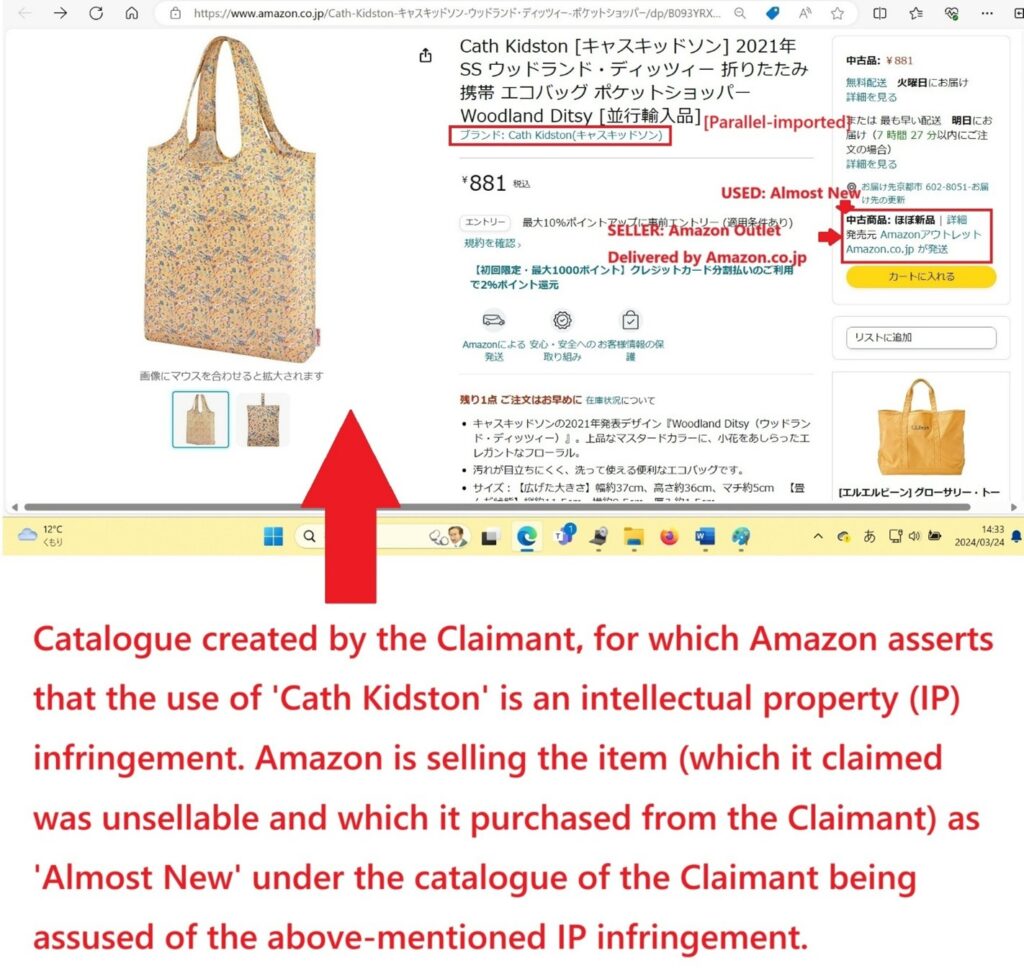Acts of torts by Amazon [Appendix 1-20]. Amazon’s claim that the use of ‘Cath Kidston’ is an Intellectual Property Infringement (trademark violation)
Although Amazon removed the Cath Kidston item which the Claimant had sold in the past on the grounds that it was a trademark violation, Amazon itself is selling an item purchased from the Claimant and listed on the catalogue the Claimant had created for the item.
The Claimant purchased all Cath Kidston merchandise from the same company (i.e. Cath Kidston store). Therefore, if Amazon claimed one genuine item from Cath Kidston to be a trademark violation, the other 303 should also have been the subject of trademark violations. Indeed, this is apparent in cases involving other Intellectual Property infringement claims where Amazon removed all items using the brand names from their website, such as those in Appendix 1-18 and Appendix 1-19.
However, there has been no problem with any other sellers (except the Claimant) selling Cath Kidston items using the catalogues which the Claimant had listed.
Furthermore, on 2 November 2023, Amazon damaged a Cath Kidston shopper bag in their warehouse which the Claimant was selling at 2980 yen – this was a different Cath Kidston item from that being claimed as an Intellectual Property infringement (Appendix 1-20). Amazon informed the Claimant that it had refunded her 1929 yen, which it believed would be sufficient for the item. In fact, the Claimant will explain in the next Brief whether the amount of reimbursement offered one-sidedly by Amazon is appropriate in terms of taking ownership of their own mistakes.
The shopper bag which Amazon admitted it had damaged and bought from the Claimant was listed as being ‘out of stock’ on the catalogue on 11 January 2024 as it was the last one to be sold. Fifteen days later, on 26 January 2024, Amazon claimed an Intellectual Property infringement for another item which the Claimant had also purchased from Cath Kidston and sold in the past (Item referred to in Appendix 1-20) and removed the item the following day.
Amazon informed the Claimant that the shopper bag became impossible to sell due to damage, which it admitted was its fault. However, it disclosed not only to the Claimant but also to consumers considering purchasing the item what damage the item had suffered. Yet Amazon does not explain defects to consumers, which a consumer article explains is ‘the problem in buying from Amazon Outlet’. However, although Amazon claimed an Intellectual Property infringement (Trademark: Cath Kidston) for the Claimant’s item and removed it from the Amazon website, it started selling the shopper bag – which it damaged in their warehouse and bought from the Claimant at 881 yen – as an Amazon Outlet on the Cath Kidston catalogue created by the Claimant, rather than on its own Cath Kidston brand store (see below).

Thus, although Amazon claimed the item (Appendix 1-20) which the Claimant was selling in the past was a trademark violation and removed it from their website, it is selling a Cath Kidston shopper bag (which the Claimant being accused of the trademark violation was selling) it bought from the Claimant, despite having informed the Claimant the item was damaged (unsellable), and is listing it as ‘Used: Almost New’ (hence it is not disclosing any faults with the item whatsoever). Such action constitutes an act of tort infringing a trademark (Presumption of negligence in Article 39 of the Trademark Act) as it cannot be acknowledged that the item in question has been put in the channel of distribution in accordance with the will of the Cath Kidston company. Moreover, it contradicts the assertion that Amazon actively engages in removing suspected listings in line with their brand protection policy.
In the Seller Forum, a seller pointed out that counterfeits confiscated by Amazon have been resold as Amazon Outlet items. Therefore, there are several cases in which consumers have become victims.
Read about this in more detail: Claimant’s Brief 12 (pp.7-12)







